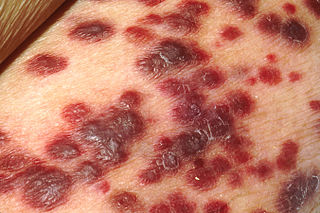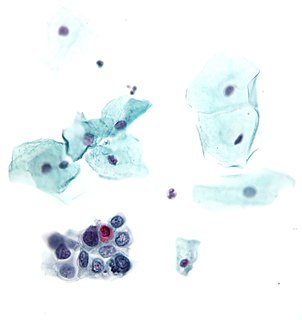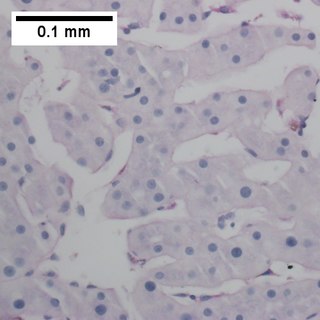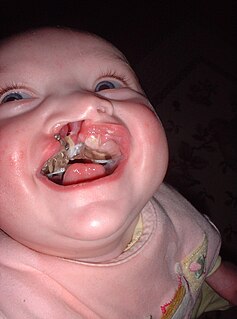
Sea turtles, sometimes called marine turtles, are reptiles of the order Testudines and of the suborder Cryptodira. The seven existing species of sea turtles are the green sea turtle, loggerhead sea turtle, Kemp's ridley sea turtle, olive ridley sea turtle, hawksbill sea turtle, flatback sea turtle, and leatherback sea turtle.

A soft-tissue sarcoma(STS) is a form of sarcoma that develops in connective tissue, though the term is sometimes applied to elements of the soft tissue that are not currently considered connective tissue. There are a number of types.

Cheloniidae is a family of typically large marine turtles that are characterised by their common traits such as, having a flat streamlined wide and rounded shell and almost paddle-like flippers for their forelimbs. The six species that make up this family are: the green sea turtle, loggerhead sea turtle, olive ridley sea turtle, hawksbill sea turtle, flatback sea turtle and the Kemp's ridley sea turtle.

Kaposi's sarcoma-associated herpesvirus (KSHV) is the ninth known human herpesvirus; its formal name according to the International Committee on Taxonomy of Viruses (ICTV) is Human gammaherpesvirus 8, or HHV-8 in short. Like other herpesviruses, its informal names are used interchangeably with its formal ICTV name. This virus causes Kaposi's sarcoma, a cancer commonly occurring in AIDS patients, as well as primary effusion lymphoma, HHV-8-associated multicentric Castleman's disease and KSHV inflammatory cytokine syndrome. It is one of seven currently known human cancer viruses, or oncoviruses. Even after so many years of discovery of KSHV/HHV8, there is no known cure for KSHV associated tumorigenesis.

A precancerous condition is a condition or lesion involving abnormal cells which are associated with an increased risk of developing into cancer. Clinically, precancerous conditions encompass a variety of conditions or lesions with an increased risk of developing into cancer. Some of the most common precancerous conditions include certain colon polyps, which can progress into colon cancer, monoclonal gammopathy of undetermined significance, which can progress into multiple myeloma or myelodysplastic syndrome. and cervical dysplasia, which can progress into cervical cancer. Pathologically, precancerous lesions can range from benign neoplasias, which are tumors which do not invade neighboring normal tissues or spread to distant organs, to dysplasia, which involves collections of abnormal cells which in some cases have an increased risk of progressing to anaplasia and invasive cancer. Sometimes the term "precancer" is also used for carcinoma in situ, which is a noninvasive cancer that has not progressed to an aggressive, invasive stage. As with other precancerous conditions, not all carcinoma in situ will progress to invasive disease.

The green sea turtle, also known as the green turtle, black (sea) turtle or Pacific green turtle, is a species of large sea turtle of the family Cheloniidae. It is the only species in the genus Chelonia. Its range extends throughout tropical and subtropical seas around the world, with two distinct populations in the Atlantic and Pacific Oceans, but it is also found in the Indian Ocean. The common name refers to the usually green fat found beneath its carapace, not to the color of its carapace, which is olive to black.
A passenger virus is a virus that is frequently found in samples from diseased tissue, such as tumours, but does not contribute to causing the disease.

Primary effusion lymphoma (PEL) is a B-cell lymphoma, presenting with a malignant effusion without a tumor mass.

Human herpesvirus 6 (HHV-6) is the common collective name for Human betaherpesvirus 6A (HHV-6A) and Human betaherpesvirus 6B (HHV-6B). These closely related viruses are two of the nine herpesviruses known to have humans as their primary host.

Kaposi's sarcoma (KS) is a type of cancer that can form masses in the skin, lymph nodes, or other organs. The skin lesions are usually purple in color. They can occur singularly, in a limited area, or be widespread. It may worsen either gradually or quickly. Lesions may be flat or raised. Human herpesvirus 8 (HHV8) is found in the lesions of all those who are affected. Risk factors include poor immune function, either as a result of disease or specific medications, and chronic lymphedema.

Cephalopod ink is a dark-coloured ink released into water by most species of cephalopod, usually as an escape mechanism. All cephalopods, with the exception of the Nautilidae and the Cirrina, are able to release ink.
Spirorchiidae is a family of digenetic trematodes. Infestation by these trematodes leads to the disease spirorchiidiosis. Spirorchiids are mainly parasites of turtles. It has been synonymised with Proparorchiidae Ward, 1921, Spirorchidae Stunkard, 1921, and Spirorchiidae MacCallum, 1921.

Threats to sea turtles are numerous and have caused many sea turtle species to be endangered. Of the seven extant species of sea turtles, six in the family Cheloniidae and one in the family Dermochelyidae, all are listed on the IUCN Red List of Endangered Species. The list classifies six species of sea turtle as "threatened", two of them as "critically endangered", one as "endangered" and three as "vulnerable". The flatback sea turtle is classified as "data deficient" which means that there is insufficient information available for a proper assessment of conservation status. Although sea turtles usually lay around one hundred eggs at a time, on average only one of the eggs from the nest will survive to adulthood. While many of the things that endanger these hatchlings are natural, such as predators including sharks, raccoons, foxes, and seagulls, many new threats to the sea turtle species have recently arrived and with

Turtle leeches are a genus, Ozobranchus, of leeches (Hirudinea) that feed exclusively on the blood of turtles. Only two species – Ozobranchus margoi and Ozobranchus branchiatus – are found in the Atlantic coast of the United States and the Gulf of Mexico. Little is known about these leeches due to difficulties in studying their sea turtle hosts.
Chelonitoxism is a type of food poisoning from eating marine turtles. It is considered rare.
Cape Byron Marine Park is one of four Marine Parks in New South Wales, Australia, and is the most recently sanctioned. The Cape Byron Marine Park is located in Northern NSW and extends 37 kilometres (23 mi) from the Brunswick River to Lennox Head. The Marine Park extends out to 3 nautical miles which dictates the border between state and federal jurisdiction. The marine park covers the area of 220 square kilometres (85 sq mi) and includes a variety of marine terrain including beaches, rocky shores, open ocean and the tidal waters of the Brunswick River and its tributaries, the Belongil creek and Tallow Creek. The Cape Byron Marine Park was declared in 2002 and the zoning plan was implemented in April 2006. Of the 15 distinct marine ecosystems identified within the Tweed-Moreton bioregion, the Cape Byron Marine Park supports 10 of these.
Platylepas hexastylos is a species of barnacle in the family Platylepadidae. It is native to the Indo-Pacific Ocean where it lives as a symbiont of such large marine creatures as the dugong, the green sea turtle, the olive ridley sea turtle, or the loggerhead sea turtle.
Ozobranchus branchiatus is a species of leech in the family Ozobranchidae. It is found in the Atlantic Ocean and is a permanent parasite of sea turtles, mostly the green sea turtle.

Chelonid alphaherpesvirus 5 (ChHV-5) is a species of virus in the genus Scutavirus, subfamily Alphaherpesvirinae, family Herpesviridae, and order Herpesvirales.

Multifactorial diseases are not confined to any specific pattern of single gene inheritance and are likely to be associated with multiple genes effects together with the effects of environmental factors.














